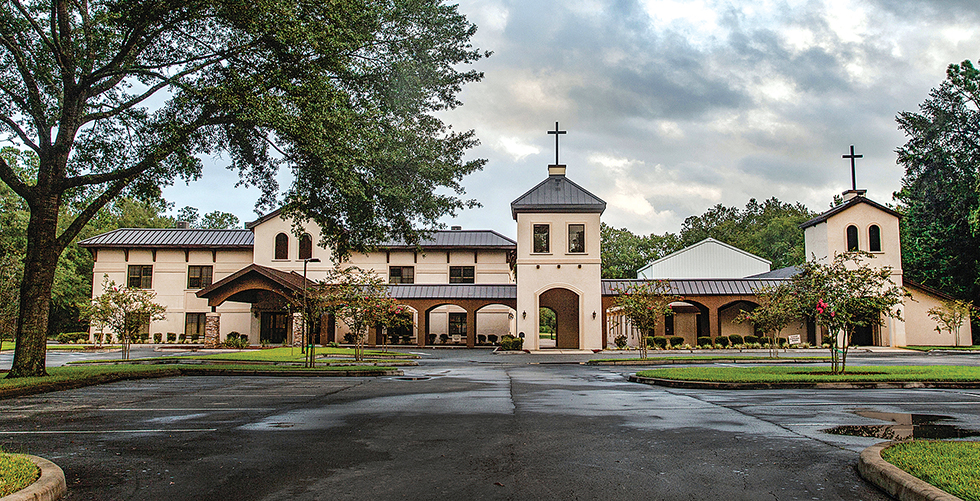
By RaeAnn Slaybaugh
 A Florida church’s design proves big impact is possible on a budget
A Florida church’s design proves big impact is possible on a budget
For Westside Family Worship Center in Jacksonville, Fla., everything changed overnight.
Always a strong military community, the closure of a nearby Navy base meant the church immediately lost 60 families.
Meanwhile, left empty, multiple mobile parks across the street from the church — previously used to house young military families — became a haven for registered offenders and meth labs.
WFWC Founding Pastor Jim Wilder had a tough decision: relocate or stay where the church was planted … and recalibrate.
He met with numerous consultants to talk about the options.
“We were advised over and over, relocate,” he recalls. “They said we’d never be able to build a sustainable ministry because of the area.”
But the church was established in its location, dating back to its founding in 1987. “You just can’t pack up and go,” Wilder explains.
So, he chose to stay. And that was the start of a rough — but ultimately gratifying — road.

“We had to retool”
This was the time to “dig in,” and that’s exactly what Wilder did.
At the time, the WFWC campus was composed of just two facilities: one brick, one metal. “We basically had two unattractive buildings in a depressed community,” he recalls. “We knew we needed to do something big.”

The vision was clear: a true transformation. A facelift. A relaunch. And it all needed to happen on a budget.
With nothing short of a total transformation in mind, he called an old friend: Charlie Daniels, owner of Churches by Daniels. The two had known each other since college. Wilder was also close friends with Charlie’s father, a pastor and church builder himself.
When they met to discuss the project, Daniels knew right away it would be a challenge. With a cap of $2 million — and existing church debt of $400,000 — “truly transformative” options were limited.
“But [Wilder] really wanted to put a good face on the church,” Daniels recalls. “He wanted to demonstrate a new direction — not just in the ministry, but in the buildings.”
Committed, Wilder and his team dug even deeper, stepping out in faith to raise $1 million in cash over four years. “You’d have to know our people, but that was unheard of,” he remembers. “Usually we’re giving money out, not receiving it.”
Those hard-earned funds enabled the church to expand the project scope.
First things first
Immediately, Wilder and Daniels agreed that the new facility must function properly and accommodate future growth. Appealing to a new faction of potential members was a key element of both objectives.
Looking around the area, they noted two very strong Catholic churches. This informed a mission-style façade at WFWC, with three towers, crosses, stucco finishes and arches.
The two previously disjointed buildings on the campus were connected by covered walkways — a must in sunny, hot (and sometimes rainy) Florida, but also acting as a visual ‘bridge.’
Inside, Wilder and Daniels agreed on the need for children’s spaces and a nursery near the sanctuary. Previously, these were housed in another building. “That just wasn’t very appealing,” Wilder says. “A young family comes to church with their kids, for the first time, and they have to drop them off in a strange place? No.”
Before the renovation, there was no lobby, either.
“You walked in the door and you were in the building,” Wilder recalls. “We just really needed transition space.”
Other important additions included a coffee shop and connected courtyard with fountain, new offices, and classrooms.
The church even added a two-story multipurpose facility housed (for now) in a metal building.
“If you drove by the church six months later, it wouldn’t have looked like the same property,” Daniels says.
Indeed, as the photos show, the result — aesthetically — is nothing short of a total transformation.
All that … and more
But as mentioned, to be considered a true success, the project would also need to accommodate future growth. To this end, Wilder “bit the bullet” and spent significant funds to lay the infrastructure the church will need for decades. Underground power supplies, drainage, curbs and gutters were all added. Two parking lots, not one, were paved.
“We knew it would cost more if we had to add it later,” Wilder explains.
He’s right: Daniels encourages every church to do the same, if funds allow. “Just this weekend, I worked on a project where the sitework infrastructure alone is $62 per square foot,” he points out.
Although that figure represents a significant portion of the budget, it’s less expensive than digging up those elements, or redoing it all, on a second project.
A rising tide lifts all boats
WFWC’s commitment to its community has been beneficial well outside the church’s four walls.
As Wilder explains, the area is currently seeing a resurgence. A large, single-family housing community is being built next door. Other developers are also moving into the area.
“It’s all coming back,” Wilder says. “The future looks so much better. It’s been a tough rebuild, but I like to think we had something to do with it.”
Daniels echoes the sentiment, and says, for his own part, the project definitely had an impact.
“WFWC wasn’t a large project, but it’s one of my favorites,” he says. “It just changed the church so dramatically. It’s really unbelievable.”


